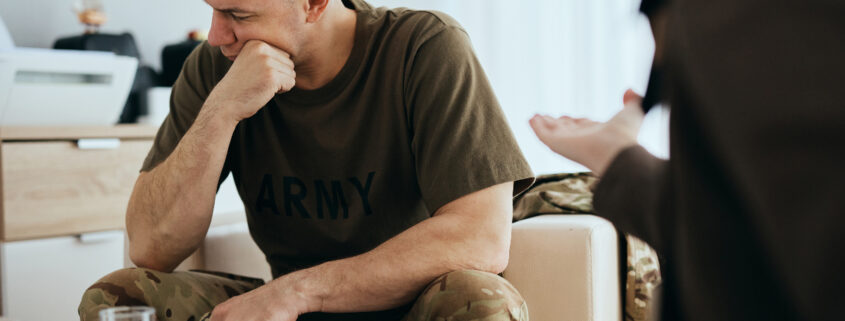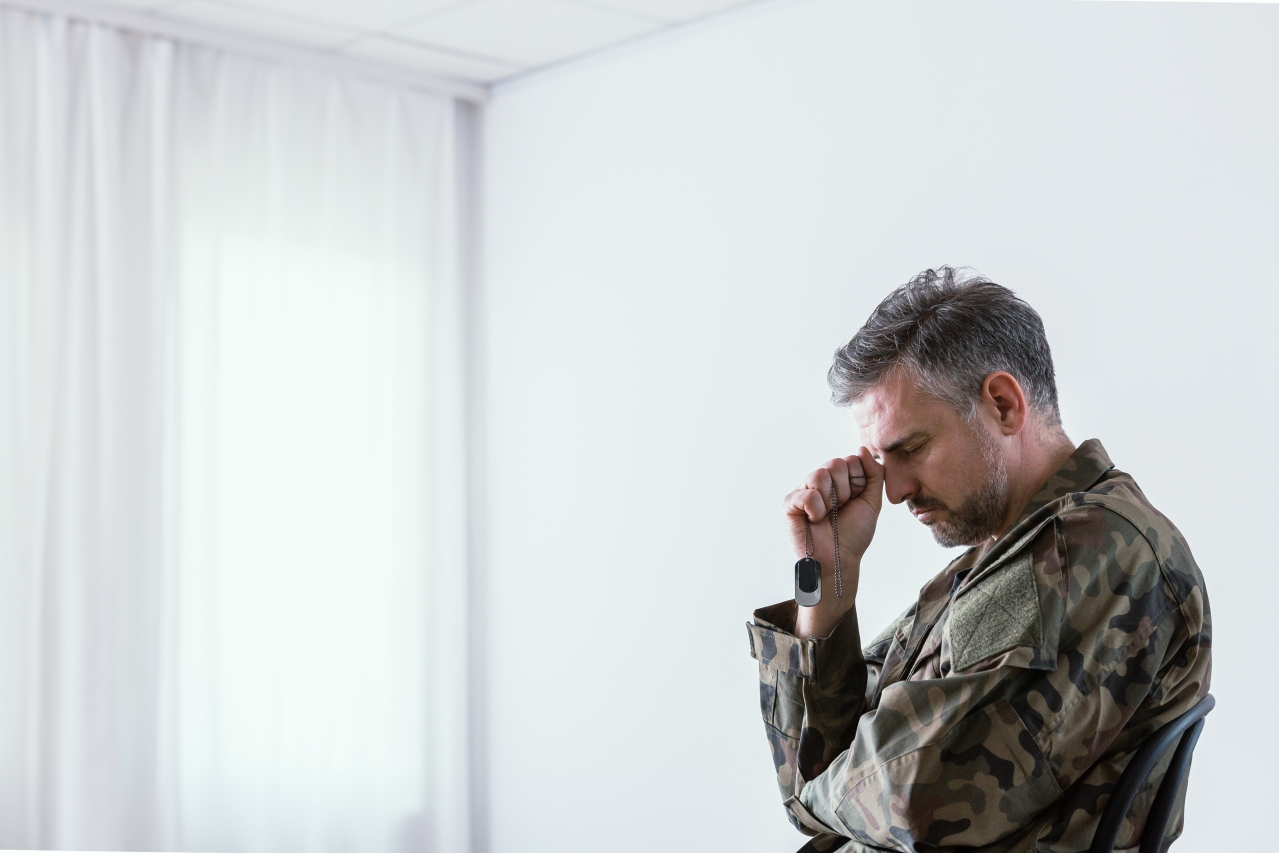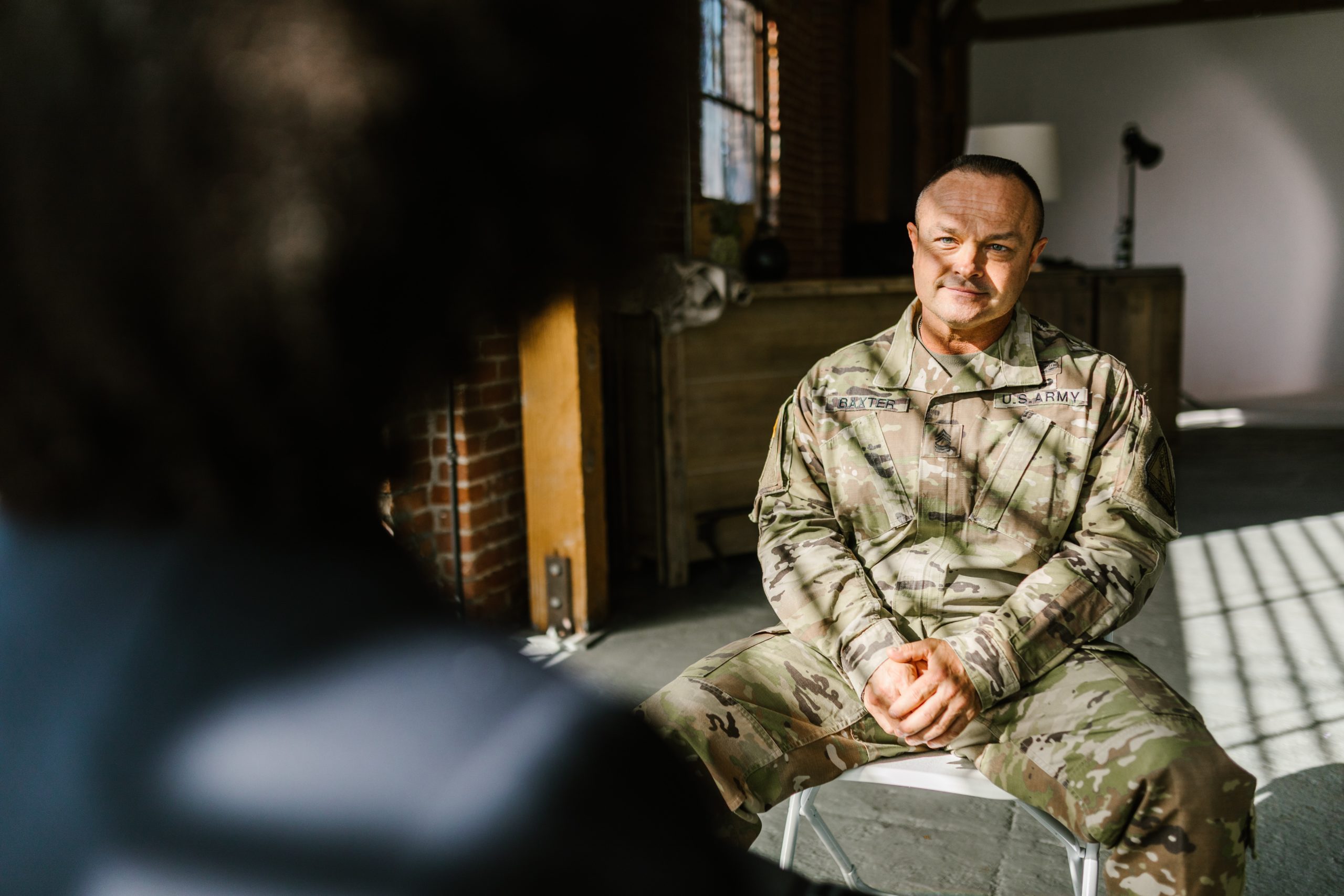Managing War Flashbacks: Tips for Coping with PTSD
War flashbacks are a distressing symptom of post-traumatic stress disorder (PTSD) that can have a significant impact on the lives of those who experience them. Understanding PTSD and war flashbacks is crucial in learning how to manage and cope with this condition effectively.
Understanding PTSD and War Flashbacks
Defining Post-Traumatic Stress Disorder (PTSD)
Post-Traumatic Stress Disorder (PTSD) is a psychological disorder that can occur after experiencing or witnessing a traumatic event. It is not limited to any specific group of people, but it is prevalent among individuals who have served in the military and have been exposed to combat or other forms of violence. PTSD can have a profound impact on a person’s mental and emotional well-being, often causing significant distress and impairing their ability to function in daily life.
People with PTSD may experience a range of symptoms, including intrusive thoughts, nightmares, flashbacks, hypervigilance, and avoidance of reminders of the traumatic event. These symptoms can be debilitating and can significantly affect a person’s quality of life. It is important to note that not everyone who experiences a traumatic event will develop PTSD, as individual resilience and coping mechanisms play a role in determining the likelihood of developing the disorder.
The Connection Between War and PTSD
War is a traumatic experience that can have long-lasting effects on individuals. The intensity and frequency of combat situations and other traumas experienced during war can lead to the development of PTSD and subsequent war flashbacks. The unique challenges faced by military personnel in war zones, such as constant exposure to life-threatening situations, witnessing the suffering of others, and the loss of comrades, can leave lasting psychological scars.
It is important to recognize that PTSD is not a sign of weakness or a character flaw. It is a natural response to an abnormal and overwhelming situation. The experiences of war can deeply impact individuals, altering their perception of the world and their sense of safety. The psychological wounds inflicted by war may not be immediately apparent, but they can manifest in various ways, including through war flashbacks.
What are War Flashbacks?
War flashbacks are vivid and intrusive memories of traumatic events that occur suddenly and can feel as if the individual is reliving the experience. They can be triggered by various stimuli, such as sights, sounds, smells, or even specific situations that resemble the original traumatic event. These flashbacks can be overwhelming and distressing, causing intense emotions and physical sensations.
During a war flashback, individuals may feel as though they are transported back to the traumatic event, experiencing the same fear, helplessness, and horror they felt at the time. The memories can be so vivid that they disrupt daily life, making it difficult to concentrate, sleep, or engage in regular activities. It is not uncommon for individuals to avoid triggers that remind them of the traumatic event, leading to a restricted and isolated lifestyle.
War flashbacks are not limited to visual images; they can also involve auditory and sensory experiences. For example, the sound of gunfire or the smell of burning can trigger a flashback, transporting the individual back to the war zone. These sensory triggers can be particularly distressing as they engage multiple senses, intensifying the re-experiencing of the traumatic event.
It is important to note that war flashbacks are not a deliberate choice or a sign of weakness. They are involuntary responses to the trauma experienced during war. Seeking professional help and support from mental health professionals is crucial in managing and coping with war flashbacks and the overall impact of PTSD.
What causes flashbacks?
War flashbacks in veterans are caused by a combination of factors stemming from their exposure to traumatic events during military service. These events can range from combat operations, witnessing death or severe injury, personal threats to safety, to other high-stress experiences associated with warfare.
What are flashbacks like?
- Vividness: Flashbacks can be so vivid that individuals may lose touch with the present, feeling as if they are back in the time and place of the traumatic event.
- Involuntary: They are not initiated by conscious thought and can be triggered by seemingly unrelated events, sounds, smells, or even emotional states.
How long do flashbacks last?
The duration of flashbacks can vary significantly among individuals and even from one episode to another for the same person. They can last from a few seconds to several minutes, and in some cases, they might extend to hours. However, most flashbacks are brief, often lasting just a short period before the individual is able to reconnect with the present. The intensity and duration of a flashback can be influenced by multiple factors, including the individual’s overall mental health, the context in which the flashback occurs, their stress levels at the time, and their environment. Effective management strategies, such as grounding techniques and professional therapy, can help reduce both the frequency and duration of flashbacks over time.
How often do flashbacks occur?
For veterans, the frequency of flashbacks can vary widely due to the unique nature of each individual’s experiences, their resilience, and the specific traumas they endured. There isn’t a one-size-fits-all answer, as factors like the type of combat exposure, personal history, mental health, and the presence of a supportive environment play significant roles in the manifestation of symptoms like flashbacks.
Some veterans might experience flashbacks multiple times a week, especially in periods of high stress or when they encounter triggers that remind them of traumatic events. Others may have them less frequently, such as once a month or even less often. The variability is influenced by:
- Severity and type of PTSD: The nature and severity of Post-Traumatic Stress Disorder (PTSD) can affect how often flashbacks occur. Complex PTSD, resulting from prolonged exposure to traumatic situations, might lead to more frequent flashbacks.
- Stage of treatment and recovery: Veterans who are in the early stages of treatment for PTSD might experience flashbacks more frequently as they begin to confront and process traumatic memories. Over time, and with effective therapy, the frequency of flashbacks can decrease.
- Personal resilience and coping strategies: Individual differences in resilience and the development of coping mechanisms, such as mindfulness and grounding techniques, can influence the frequency of flashbacks.
- Environmental and emotional triggers: Encounters with specific sights, sounds, or situations that remind the veteran of their traumatic experiences can trigger flashbacks. Reducing exposure to known triggers can help manage the frequency of these episodes.
It’s crucial for veterans experiencing frequent or severe flashbacks to seek professional help. Treatments such as cognitive-behavioral therapy (CBT), eye movement desensitization and reprocessing (EMDR), and medication, along with strong social support, can significantly improve symptoms and reduce the impact of flashbacks on a veteran’s life.
The Impact of PTSD on Daily Life
Post-Traumatic Stress Disorder (PTSD) is a mental health condition that can have profound effects on an individual’s daily life. It is often caused by experiencing or witnessing a traumatic event, such as military combat, sexual assault, or a natural disaster. While the symptoms of PTSD vary from person to person, they can significantly impact emotional well-being, physical health, and social interactions.
Emotional Consequences of PTSD
One of the most challenging aspects of living with PTSD is the emotional toll it takes on individuals. PTSD often leads to heightened feelings of anxiety, fear, and anger. These emotions can be overwhelming and make it challenging for individuals to engage in daily activities, form and maintain relationships, and experience a sense of overall well-being. The constant state of hypervigilance and the fear of potential triggers can create a constant sense of unease and distress.
Furthermore, individuals with PTSD may also experience intense feelings of guilt, shame, and self-blame. They may blame themselves for the traumatic event or feel guilty for surviving when others did not. These emotional burdens can further exacerbate the challenges faced in daily life and hinder the healing process.
Physical Symptoms of PTSD
PTSD can also manifest physically, adding an additional layer of difficulty to an individual’s daily life. The constant state of stress and anxiety associated with PTSD can result in a range of physical symptoms. Insomnia, for example, is a common symptom experienced by individuals with PTSD. The intrusive thoughts and nightmares that often accompany the disorder can make it difficult to fall asleep or stay asleep throughout the night.
In addition to sleep disturbances, individuals with PTSD may also suffer from frequent headaches, gastrointestinal problems, and muscle tension. These physical symptoms can further contribute to the distress experienced by individuals with PTSD, making it challenging to engage in regular activities and maintain a healthy lifestyle.
Social Implications of PTSD
Living with PTSD can have significant social implications, affecting an individual’s ability to connect with others and participate in social activities. The fear of triggering a flashback or being misunderstood by others may lead to isolation and withdrawal from social settings. Individuals with PTSD may find it difficult to feel comfortable in social situations, constantly on edge and anticipating potential triggers.
Furthermore, the symptoms of PTSD, such as irritability, anger outbursts, and emotional numbing, can strain relationships with family, friends, and colleagues. The emotional volatility associated with the disorder can make it challenging for others to understand and provide the necessary support. As a result, individuals with PTSD may find themselves feeling isolated and disconnected from their support networks, further exacerbating the impact on their daily lives.
PTSD has a profound impact on an individual’s daily life, affecting their emotional well-being, physical health, and social interactions. The constant struggle with heightened emotions, physical symptoms, and social challenges can make even the simplest tasks feel overwhelming. It is crucial to provide support and understanding to individuals living with PTSD, as they navigate the complexities of their daily lives and work towards healing and recovery.
Techniques for Managing War Flashbacks
War flashbacks can be incredibly distressing for individuals who have experienced traumatic events. These vivid and intrusive memories can transport them back to the horrors of war, making it difficult to focus on the present moment. However, there are several techniques that can help manage and reduce the impact of war flashbacks.
Grounding Techniques for PTSD
Grounding techniques are a valuable tool for individuals struggling with war flashbacks. These techniques aim to reconnect individuals with the present moment, helping them regain a sense of safety and stability. One effective grounding technique involves focusing on the five senses.
For example, individuals can engage in tactile grounding by feeling different textures. They can run their fingers over a smooth stone, touch the rough bark of a tree, or hold a soft piece of fabric. By redirecting their attention to the physical sensations in their hands, they can shift their focus away from the flashback and back to the present.
Similarly, auditory grounding techniques involve listening to soothing sounds. This could be the gentle rustling of leaves, the calming sound of raindrops, or even a favorite song. By immersing themselves in these sounds, individuals can create a sense of calm and tranquility, helping to alleviate the distress caused by war flashbacks.
Additionally, olfactory grounding techniques involve smelling pleasant scents. Aromatherapy can be particularly helpful in this regard. Individuals can use essential oils, such as lavender or chamomile, to create a calming and soothing environment. The aroma of these scents can help anchor individuals to the present moment and provide a sense of comfort.
Cognitive Behavioral Therapy (CBT) for PTSD
Cognitive-behavioral therapy (CBT) is an evidence-based psychological treatment that has shown great effectiveness in managing and reducing the impact of war flashbacks and PTSD. This therapeutic approach focuses on identifying and modifying negative thought patterns and behaviors associated with traumatic memories.
During CBT sessions, individuals work closely with a therapist to explore the underlying beliefs and assumptions that contribute to their war flashbacks. By challenging and reframing these negative thoughts, individuals can gradually reduce their intensity and frequency. Through various techniques, such as cognitive restructuring and exposure therapy, CBT empowers individuals to regain control over their traumatic memories.
Moreover, CBT equips individuals with coping strategies and skills to manage distressing emotions and triggers associated with war flashbacks. These skills may include relaxation techniques, such as deep breathing exercises or progressive muscle relaxation, as well as stress management strategies like mindfulness and meditation.
Eye Movement Desensitization and Reprocessing (EMDR)
Eye Movement Desensitization and Reprocessing (EMDR) is a therapy technique specifically designed to alleviate the distress caused by traumatic memories, including war flashbacks. This approach combines elements of cognitive therapy, exposure therapy, and bilateral stimulation to help individuals process and integrate their traumatic experiences.
During an EMDR session, individuals focus on a traumatic memory while simultaneously engaging in bilateral stimulation. This can be done through guided eye movements, tapping, or auditory cues. The bilateral stimulation helps stimulate both sides of the brain, facilitating the processing and reintegration of the traumatic memory.
Through repeated sessions of EMDR, individuals often experience a reduction in the intensity and emotional charge associated with their war flashbacks. The therapy helps them reprocess the traumatic memories in a more adaptive and less distressing way, ultimately leading to a decrease in the frequency and severity of the flashbacks.
It is important to note that while these techniques can be highly effective, they may not work for everyone. Each individual’s experience with war flashbacks and PTSD is unique, and it is essential to consult with a mental health professional to determine the most appropriate treatment approach.
Self-Care Strategies for People with PTSD
Post-Traumatic Stress Disorder (PTSD) is a mental health condition that can develop after experiencing or witnessing a traumatic event. It is characterized by symptoms such as intrusive memories, flashbacks, and intense anxiety. While professional help is essential for managing PTSD, there are self-care strategies that individuals can incorporate into their daily lives to help alleviate symptoms and improve overall well-being.
Importance of Regular Exercise
Regular exercise is not only beneficial for physical health but also plays a significant role in managing PTSD symptoms. Engaging in aerobic activities or practicing yoga can help reduce the severity and frequency of war flashbacks. When we exercise, our bodies release endorphins, which are natural chemicals that promote feelings of well-being and happiness. These endorphins act as natural painkillers and mood elevators, helping individuals better cope with stress and trauma.
In addition to the release of endorphins, exercise can also provide a distraction from intrusive thoughts and memories. By focusing on physical activity, individuals can redirect their attention away from the distressing symptoms of PTSD. Moreover, exercise can improve sleep quality, reduce anxiety, and enhance overall mood, all of which are crucial for individuals with PTSD.
Balanced Diet and PTSD
Maintaining a balanced diet is essential for everyone, but it can have a particularly positive impact on individuals with PTSD. Consuming nutrient-rich foods can support brain function and enhance mood stabilization, reducing the intensity of war flashbacks and other PTSD symptoms.
Specific nutrients, such as omega-3 fatty acids found in fish, nuts, and seeds, have been shown to have a positive effect on mental health. These fatty acids play a crucial role in brain function and can help regulate mood and reduce anxiety. Additionally, incorporating whole grains, fruits, and vegetables into the diet can provide essential vitamins and minerals that support overall well-being.
It is important to note that while a balanced diet can have a positive impact on mental health, it is not a substitute for professional treatment. Individuals with PTSD should consult with a healthcare professional to develop a comprehensive treatment plan.
The Role of Adequate Sleep
Getting enough sleep is essential for individuals with PTSD. Sleep deprivation can exacerbate symptoms, making war flashbacks and other difficulties associated with PTSD more challenging to manage. Establishing a bedtime routine and creating a conducive sleep environment can improve sleep quality.
Creating a calming sleep environment involves minimizing distractions, such as electronic devices, and ensuring the bedroom is dark, quiet, and comfortable. Engaging in relaxation techniques before bed, such as deep breathing exercises or meditation, can also help calm the mind and promote better sleep.
Additionally, individuals with PTSD may benefit from practicing good sleep hygiene, which includes maintaining a consistent sleep schedule, avoiding caffeine and stimulating activities close to bedtime, and creating a relaxing pre-sleep routine. Adequate sleep can enhance overall well-being, improve mood, and provide individuals with the energy needed to cope with the challenges of PTSD.
By understanding PTSD and war flashbacks, individuals can develop effective strategies for managing and coping with these symptoms. Techniques such as grounding, therapy, and self-care strategies play crucial roles in helping individuals regain control of their lives and find relief from the distress caused by war-related trauma.






